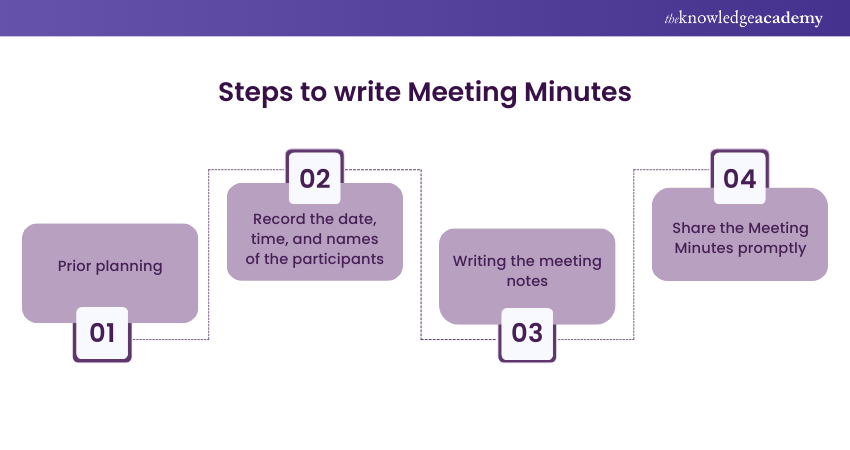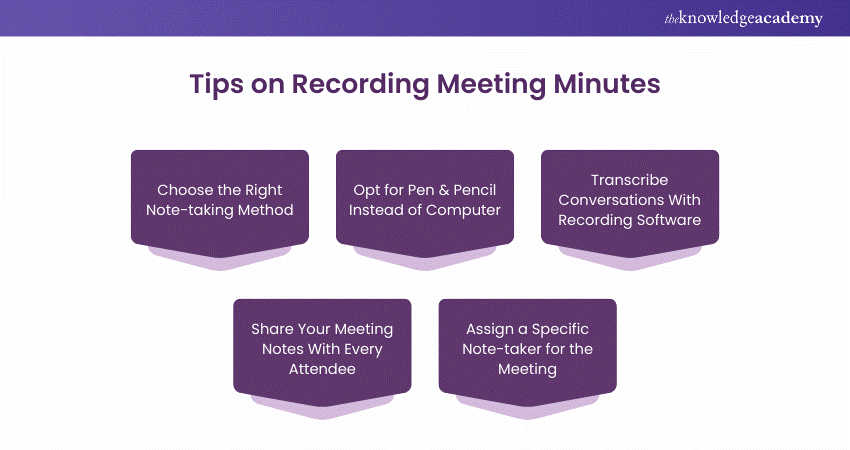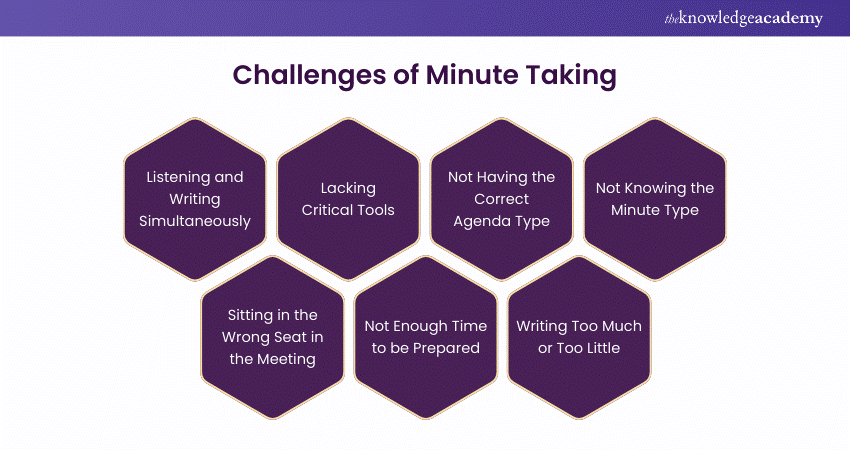We may not have the course you’re looking for. If you enquire or give us a call on + 1-866 272 8822 and speak to our training experts, we may still be able to help with your training requirements.
Training Outcomes Within Your Budget!
We ensure quality, budget-alignment, and timely delivery by our expert instructors.

Imagine a meeting as a vibrant melting pot where minds and ideas converge to shape the future of an organisation.In this context, the Minutes of the Meeting serve as the essential map that charts this journey. These minutes are the written record of all critical decisions made during the meeting. So, learning How to Take Minutes in a Meeting with a standardised approach is essential to avoid any confusion.
This blog explores the importance, the best tips and techniques on How to Take Minutes in a Meeting with greater efficiency. Let’s dive in and explore various methods to master this skill, ensuring your team stays aligned on all decisions.
Table of contents
1) What are Meeting Minutes?
2) How to Take Meeting Minutes?
a) Prior Planning
b) Record the Date, Time, and Names of the Participants
c) Writing the Meeting Notes
d) Share the Meeting Minutes Promptly
3) Tips to Efficiently Record Meeting Minutes
4) Challenges in Taking a Minute in a Meeting
5) Conclusion
What are Meeting Minutes?
The Meeting Minutes are the written document of all the important decisions that are made during the meeting period. Whether for an organisation’s board of directors, leaders, or investors, this knowledge is easily transferable. They are often referred to as ‘Minutes Of Meetings’ (MoM).
The written record or transcript of a meeting can be used to give information to members who missed it on what decisions were made. It is also a note to look back at for decisions which can be revisited later.
How to Take Meeting Minutes?
Now that you know what minutes of the meeting are, let's explore how to write it. Writing Minutes of the Meeting is rather simple if you follow these four steps:

a) Prior Planning
Preparing for the meeting well in advance, is a great way to make the task of note-taking easier. Talk to the person in charge prior to the meeting to get an idea of the meeting's agenda so you can prepare your talking points well in advance.
Identifying the intentions of the meeting and what will be discussed prepares you to take notes. You can prepare notes on the talking points, the purpose of the meeting, and the time frame before starting to structure your minutes.
Take the next step towards enhancing your professional skills in administration and secretarial roles with our PA and Secretarial Training – sign up now!
b) Record the Date, Time, and Names of the Participants
Make sure to state the date and time of the meeting before you move on to drafting the minutes. I think it goes without saying that it’s a must to provide some means of going back to the past meetings where a person will be able to see what has been done, what still needs to be done, and how far a team has come in its process.
A new step after that involves putting down all the names of those who took part and those who couldn’t join. The meeting usually starts with a review of the minutes of the last meeting, which helps you get to know in advance who was there the last time in order to have your own draft version of an attendee list. Preferably, you could utilise the calendar invite to crosscheck the names immediately as the participants start joining or entering the room.
Want to lern the art minutes taking, then refer to our blog on "Importance of Minute Taking"
c) Writing the Meeting Notes
Collect everything that you will need to write a precise meeting summary in a clear, readable format once the meeting has ended. Here are some pointers for you to keep in mind while doing so:
1) Avoid spending a lot of time waiting to write the notes, after you have attended the meeting. This will help you to recall all the actions that took place during the meeting easily.
2) Review the format that you planned earlier and make any possible adjustments beforehand. This could be to settle any queries or to provide further explanations on matters brought up. Besides that, you should have clear records of all activities, verdicts, and motions.
3) Revise your minutes so that they are crisp and clear.
4) Attach important documents
5) Proofread for clarity and eliminate grammatical or spelling errors.
Join our renowned Train the Trainer course and gain the expertise you need to inspire and educate others effectively.
d) Share the Meeting Minutes Promptly
In the first instance, the meeting notes should be sent to those leading the meeting, for example, the chair and any senior executives. Request for their consent and assess if there are other parties who also need to read and approve the summary. Make sure that all relevant people. Have approved the notes and added their signatures.
Make the corrections and approve it if there are any necessary revisions. Once you have all the necessary approvals, you can now send the meeting notes to the respective employees.
Moreover, choose a method that adapts to your business style for sharing the minutes, for example, email. Verify the list of recipients with your leaders and add any extra employees to whom you are told to send the minutes.
Unlock your potential and become a master in secretarial skills with our comprehensive Secretarial Course – Sign up now!
Tips to Efficiently Record Meeting Minutes
Taking minutes in meetings is a vital responsibility that requires careful attention and effective communication. Well-crafted Meeting Minutes provide a concise and accurate record of discussions, decisions, and action items. Here are some valuable tips for Minute-Taking that can enhance your knowledge of How to Take Meeting Minutes:

Choose a Note-taking Method that Works You
There are several different note-taking methods out there, and it's essential to settle on the one that works best for you based on your personal learning style. Some of the common note-taking methods include:
a) Cornell Method: In the Cornell method, notes take the form of two columns: A small column on the left side and a larger column on the right. The left column outlines key points from the meeting, while the right column highlights the details. Noting the main idea on the left and important details on the right can help you stay organised as the conversation shifts.
b) Outline Method: Since the meeting agenda is generally shared beforehand, use that as an outline for your notes. List the key points and agenda items, then take notes underneath each as the meeting progresses.
c) Quadrant Method: You can separate your notes into four different quadrants, labelling each section as:
a) General notes,
b) Action items for yourself
c) Action items for other team members
d) Questions
In the general notes section, note down essential details from the meeting while you can reserve the rest of the quadrants for the items underneath those headers.
d) Slide Method: If your meeting is a presentation, request the presenter to share the slide deck with you ahead of time. You can then add any notes to specific slides as the speaker presents.
Ditch the Laptop—Use Pen and Paper Instead
Research shows that taking notes using pen and paper instead of typing helps you remember conceptual information in the long term. While taking meeting notes, your focus will more likely be on the key takeaways of the meeting since it's almost impossible to jot everything down word for word. Additionally, not having your laptop prevents multitasking during team meetings.
Transcribe Conversations with Recording Software
With multiple teams working remotely, recording and sharing a video recording can be easier than writing meeting notes. You can utilise recording software to transcribe the conversation so team members can access it later. Reading a transcription lets you parse regular conversation from critical points and action items at a glance.
Before starting, alert everyone that the conversation will be recorded and what the recording will be used for. Share the recording and transcript in a central location accessible to the whole team.
Share Your Meeting Notes with All Attendees
Following up after a meeting is an excellent way to ensure all stakeholders have clarity on the decisions made. Anyone who skipped the meeting can catch up asynchronously by reading your meeting notes. Additionally, if there are any missed points, your team can add them to the follow-up notes.
After the meeting, when you follow up with stakeholders, ensure that the document is easily shareable and accessible. You must work with your team to develop a communication plan, so everyone knows where this information is stored and how to access it later.
Assign a Specific Note-taker for the Meeting
If you're leading a meeting, taking notes and facilitating the discussion can be challenging. In that case, you can ask a team member to take notes for you. You can rotate the designated note-taker for recurring meetings so that everyone can join the conversation.
Challenges in Taking Minutes in a Meeting
Here are some common challenges associated with minute taking:

1) Having to Use Two Complex Skills Simultaneously: Listening and writing simultaneously can be challenging. It's all about concentrating on what is being said while suspending your views and judgment.
2) Lacking the Critical Tools for the Job: It would help if you had these essential tools during minute-taking:
a) A supply of sharpened pencils. If you really use a pen, a lightweight, quality biro works better than most.
b) Smooth, good-quality paper.
c) An A5 spiral-bound hardcover pad. It works better than an A4 one.
d) Tent cards and a seating plan
e) The previous set of minutes and the current agenda
3) Not Having the Correct Type of Agenda: An action-centred agenda is crucial to meeting success. Send it out at least a week before the meeting and ensure it is well structured and fits into the timeframe of the meeting. It must also use some basic psychological principles about how people behave at meetings regarding time slots, running order, precise objectives for each item, pointers on any background papers and who is leading on which item.
4) Not Knowing the Type of Minute You Should be Producing: You need to know the four options beforehand. Usually, a meeting will have the same number of minutes each time and as long as they are well written, checking previous minutes will show you which type you must produce.
The types of minutes you can choose from include:
a) Verbatim (rare).
b) Narrative (commonly used).
c) Resolution (often used in public bodies).
d) Action (preferable for many types of meetings these days).
e) The layout, structure, and recording levels are different for each.
5) Sitting in the Wrong Seat: If you are taking the minutes, your place is by the chairperson.
6) Not Doing the Correct Type of Preparation: If you are new to this, you must allocate time beforehand, preferably several weeks before the meeting. Look back over six months of previous minutes of your meeting as it will show you:
a) Level of recording
b) The story so far
c) Level of detail
d) Decision-making and problem-solving methods used
e) The people involved
f) The major contributors
7) Writing Too Much or Too Little: Generally speaking, you need to note only crucial points, decisions, and actions. Practice will help you get the balance right. If you try to note too much down, you will stay caught up in the discussion, and your writing will become illegible. So, you will have a tough time transcribing it back into something concise, accurate and meaningful when you return to work.
Conclusion
In conclusion, learning How to Take Minutes in a Meeting can go a long way toward determining the meeting's success. It's about focusing on the key decisions being made, honing your listening and writing skills simultaneously, extra preparation such as knowing the nature of the meeting beforehand, and more. This blog outlines everything one needs to develop and master the craft of minute making.
Unleash your potential and master the art of shorthand with our comprehensive Shorthand Training – Sign up today!
Frequently Asked Questions

Yes, effective minute taking shows your eye for details and precision in documentation. It also displays what a valuable employee you are, and companies like to retain employees who bring value to the company as well as are experienced with the way things work in the company.

The best way to update yourself with the latest trends and improve your skills is to take up the latest workshops and courses related to PA training or minute taking training. You can also reach out to the management to cover the expenses of the course as an up-skill opportunity.

The Knowledge Academy takes global learning to new heights, offering over 30,000 online courses across 490+ locations in 220 countries. This expansive reach ensures accessibility and convenience for learners worldwide.
Alongside our diverse Online Course Catalogue, encompassing 17 major categories, we go the extra mile by providing a plethora of free educational Online Resources like News updates, Blogs, videos, webinars, and interview questions. Tailoring learning experiences further, professionals can maximise value with customisable Course Bundles of TKA.

The Knowledge Academy’s Knowledge Pass, a prepaid voucher, adds another layer of flexibility, allowing course bookings over a 12-month period. Join us on a journey where education knows no bounds.

The Knowledge Academy offers various PA and Secretarial Course, including Secretarial, Office Skills and Office Manager Courses. These courses cater to different skill levels, providing comprehensive insights into Benefits of a Company Secretary.
Our Business Skills Blogs cover a range of topics related to PA and Secretarial Courses, offering valuable resources, best practices, and industry insights. Whether you are a beginner or looking to advance your PA and Secretarial skills, The Knowledge Academy's diverse courses and informative blogs have you covered.
Upcoming Business Skills Resources Batches & Dates
Date
 Company Secretary Training Course
Company Secretary Training Course
Fri 10th Jan 2025
Fri 14th Feb 2025
Fri 11th Apr 2025
Fri 23rd May 2025
Fri 8th Aug 2025
Fri 26th Sep 2025
Fri 21st Nov 2025







 Top Rated Course
Top Rated Course



 If you wish to make any changes to your course, please
If you wish to make any changes to your course, please


